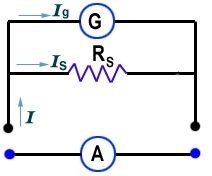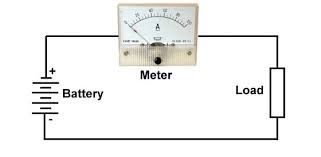Theory or Working Principle
Ammeter
It is a device to measure the electric current flowing through a circuit. Ammeter is connected in series to the circuit through which the current is to be measured because current is same in series combination.
A perfect ammeter of 100% accuracy must have zero resistance so that no potential drop occurs there without altering the actual current to be measured.
Galvanometer as an ammeter
Galvanometer can be converted into ammeter by connecting very low resistance (shunt) across its two terminals.
Working
When we apply the low resistance in parallel with galvanometer, basically we make the current flow somewhat small through galvanometer. Suppose we apply resistance to galvanometer and keep it constant, then
I α V
Deflection α I
When we apply the low resistance in parallel with galvanometer, basically we make the current flow somewhat small through galvanometer. Suppose we apply resistance to galvanometer and keep it constant, then. As there is very low resistance to current, the suitable current then flows through galvanometer so that it does not damage the galvanometer and we can say that it is equivalent to total current. It is quite wrong to say. But, actually the deflection for total current is equal to the deflection for small current (which is actually flowing through galvanometer) at that instant or configuration of system.
Desired Range Ammeter

Consider a galvanometer of resistance Rg with shunt Rs in parallel with galvanometer, as shown in fig.
Current through shunt:
Is = (I-Ig)
potential difference across the shunt:
Vs = IsRs
or Vs = (I – Ig)Rs
but Vs = Vg
(I - Ig)Rs = IgRg-------1
Where Rg is the resistance of galvanometer. Knowing all the values and putting the desired value of current I for desired range ammeter, in eq1, shunt resistance is calculated. Shunt of that much resistance is connected in parallel with galvanometer to make it desired range ammeter


1st diagram shows typical analog ammeter while second one shows shunt to the galvanometer to convert it into an ammeter.



